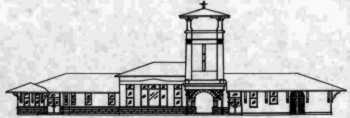 |
|
SAVING A PIECE OF HISTORY |
|
Group share hope that L&N Depot isn't lost Remember the gleaming white and columned Elks Club building that once stood at the corner of Third and Main Streets? That space is a parking lot now. Remember the historic Henderson County Courthouse that billeted Union soldiers during the Civil War? It was razed in the 1960s and a new one built in its place. Remember the old L&N Depot that stood at the north end of Clark Street and once welcomed the likes of Harry Truman, Dwight Eisenhower and Warren G. Harding? You should because it's still in existence. But it's no longer an active depot and the future of the 96-year old structure is a big question mark. Will it be preserved for the generations to come? Or will it like a number of noble buildings that marked Henderson's past eventually vanish from the scene? If the depot's relatively few visable supporters have anything to say about it, that station with the archways, cupola, and remnants of glory days not only will survive but will have a second life in the community. These individuals most of them members of the Henderson County Historical and Genealogical Society which owns the defunct station have a new vision for the place and they want to share it with all of you at a public open house next Sunday, November 2. They'll also give you the opportunity to sign a support roster which calls for the depot known as Union Station to be saved so our grandchildren can come to know the place that played such a major role in the county's economic and social history. At the event you'll meet a number of the longtime hard-working historical society members. And you'll meet one who joined only a couple of months ago, but already is heading a committee that's avidly seeking grants to fund depot renovation and make it once more a bustling site. Tentative plans call for it to house a city county museum, meeting banquet hall, lunch counter, flower shop, genealogy library and commercial kitchen. Joan SEWELL is that chairperson and she's a high-octane dynamo who sets her sights on a goal and stubbornly pursues it. She's the gal who chaired the committee that got the gazebo built in Central Park, and it's no coincidence that her motto is the venerable Scottish saying, Keep to the end of the road. If her zeal entails sometimes ruffling a few feathers, then so be it. For example, Joan whose name is pronounced JoAnn is tough on any office holder who is more concerned about climbing the political ladder than really doing something for the community. I don't try to hurt anyone's feelings, she says, but it doesn't bother me to speak my mind. People have to get out and get involved! She practices what she preaches, and in her brief stint with the historical society already has been in touch with preservationists and builders and with various foundations and agencies that award grants. And she and her husband, Dr. Frank SEWELL, have organized a local chapter of the state Junior Historical Society and regularly host the 12 members at their South Main Street home. A native of Mercer County, Joan is one of eight kids born to a farmer-builder and wife and she grew up steeped in the historical legacy of Harrodsburg and Fort Harrod, where she worked when she was in high school. Trained as a respiratory therapist and now serving as coordinator for continuing medical education programs for the 70-plus doctors on the CMK staff, she has a full plate. But this mother of two daughters finds time for plenty of other endeavors including designing special entrances for some local art shows. Just give her chicken wire, canvas, plaster and paint, she grins, and she can do just about anything. Chicken wire and canvas won't do the job at the depot, but Joan says we'll find a way. This is a do-able project, she maintains. Envious of her energy level, I asked what she eats for breakfast. I don't eat breakfast, she replied. I only have coffee. Why doesn't that surprise me? Reprinted with permission, The Gleaner, October 26, 1997
|
|
BACK Contributed by Netta Mullin, HCH&GS Copyright 2005 HCH&GS |